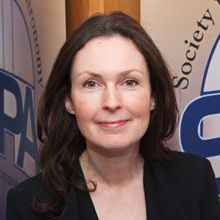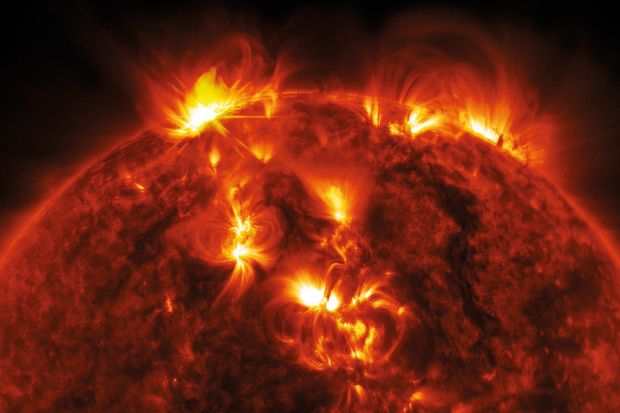Across the world, telegraph operators were electrocuted, and at low latitudes, a blood-red aurora borealis appeared, so bright it was possible to read a newspaper by it at midnight. The Carrington event, named after astronomer Richard Carrington, who noticed a flare on the Sun from south of London at the same time that a magnetometer at Kew flew off-scale, changed for ever our ideas about the Sun. Before 1 September 1859, our nearest star was believed to influence the Earth only through its gravity, and of course the warming effect of sunlight. Afterwards, it was realised that violent convulsions on the solar surface, or “photosphere”, could fire magnetic missiles at our planet with devastating effect.
Solar physicist Lucie Green is in love with solar magnetic fields (she really is!). She says her office at University College London’s Mullard Space Science Laboratory is full of pipe cleaners that she has twisted into loops and braids and spirals in an attempt to visualise what is happening on her number one favourite heavenly body. “You’ll probably end up thinking I am completely obsessed by the Sun,” she says. “And you’d be right.”
“If the Sun had no magnetic field, it would be as uninteresting as most astronomers think it is,” said the American physicist Robert Leighton. Green agrees. And she makes a very good case for why Leighton was right.
In the 1920s, the British astrophysicist Sir Arthur Eddington deduced the internal structure of the Sun and its central temperature of more than 10 million degrees merely by assuming that it is a giant ball of gas. The key to this was his recognition that, because the Sun is not noticeably expanding or contracting, every portion of its interior must be in perfect balance. In such a state of “hydrostatic equilibrium”, the force of gravity pulling inward on a chunk of solar matter must be perfectly countered by the force of the hot gas pushing outwards. Although we now know that the Sun’s heat comes from nuclear fusion of hydrogen to helium, the by-product of which is sunlight, remarkably Eddington’s conclusions did not require him to know anything about the solar heat source. The Sun’s central temperature depends in essence only on its mass, and would be the same for a similar mass of bananas, discarded Tesco plastic bags or microwave ovens.
Magnetism, however, transforms the Sun from Eddington’s predictable and somewhat dull ball of hot gas into an unpredictable, seething, explosive, infinitely surprising laboratory for extreme physics.
Magnetic fields are generated by moving electric charges. In the case of a mundane bar magnet, the movement is only of the electrons inside atoms, and the atoms stay put. The key thing to understand about the Sun is that it is not an ordinary gas – it is an electrically charged gas, or “plasma”, of nuclei and electrons. And, in the solar plasma, the moving charges that create the magnetic fields are free to move, unlike the atoms in a bar magnet. This movement changes the magnetic field, which in turn affects the movement of the charges, which changes the magnetic field again, and so on. It is this complex interplay between the hot plasma and magnetic field that is behind all the myriad solar magnetic phenomena from the magnetic whorls of sunspots to the mega-detonations of solar flares.
Actually, there is one other essential ingredient, says Green. Because the Sun is not a rigid body, its exterior rotates at a different rate from its interior, and even regions of its exterior at different latitudes rotate at different speeds. Consequently, the magnetic fields in the Sun are being continually twisted and contorted, storing up energy in exactly the same way that twisted elastic bands do.
Where loops of magnetic field break through the surface, we see sunspots – nearly always in pairs, since the loop emerges from the Sun at one point and re-enters at another. Where a magnetic field becomes so twisted that it snaps, “reconnecting” with other fields, the energy unleashed hurls million-degree plasma tens of thousands of miles above the Sun in a solar flare. There is even a million-mile-an-hour hurricane – the solar wind – that blows from the Sun, carrying its magnetic field out through the Solar System. In a very real sense, the Earth orbits inside the atmosphere of the Sun. In fact, that atmosphere comes to an end only way beyond the outermost planet, where the solar wind slams into the interstellar medium like a snow plough running into a snow drift. On 25 August 2012, Nasa’s Voyager 1 space probe, launched in 1977, detected a strong increase in “cosmic rays”, high-energy particles from our galaxy, making it the first human vehicle to leave the Sun’s atmosphere and taste interstellar space.
Although 15 Million Degrees starts off slowly, Green soon gets into her stride. She is at her most engaging when telling us what the Sun means to her and in relaying personal anecdotes, which bring her subject alive. She writes about a Sun-observing satellite currently under development by the European Space Agency: “I get very excited about Solar Orbiter. But it is hard not to get excited about a new spacecraft when bits are being put together in the building where you work!” Green’s enthusiasm for her subject is infectious. I confess that before this book I had little interest in solar magnetic fields, but now I’m fascinated.
Understanding the Sun, Green points out, is more than a mere academic activity. Our very survival on Earth may depend on understanding the “space weather” created by the nearest star. Studies of other Sun-like stars reveal that they can – admittedly not very often – launch mega-flares that are quite capable of frying a planet like the Earth. A more serious concern, however, says Green, are coronal mass ejections (CMEs), which should more accurately be called coronal magnetic eruptions. First recognised only in the 1970s, these are missile-like ejections into space of vast amounts of solar plasma and magnetic field. We are talking about something of roughly the mass of Mount Everest hurled into space at 500 times the speed of a passenger jet. The Carrington event – the most violent solar event ever recorded – is now recognised to have been a CME.
In 1859, we had the crude technology to detect a CME, but the world was not so dependent on that technology that it suffered any serious harm. Contrast this with the situation today, says Green. Changes in the magnetic field across electrical power grids can induce currents big enough to melt equipment. Such induction was behind the electrocution of telegraph operators in 1859 and a major power outage in Quebec on 13 March 1989. But the real threat today is to the dense ring of satellites that girdles our planet and on which our lives now depend. Communications satellites, weather satellites, global positioning satellites – which not only allow us to know our location but play a crucial role in global financial transactions – are all at risk. In rich countries, efforts have been made to harden infrastructure against a CME. However, it is a sobering thought that the Sun, which has given us life, could in an instant return us to a pre-electrical age.
“Our deadline to understand the Sun is becoming more urgent,” says Green. Time, as this fine book shows, is of the essence.
Marcus Chown, formerly a radio astronomer at the California Institute of Technology, is author, most recently, of What a Wonderful World: Life, the Universe and Everything in a Nutshell (2014).
15 Million Degrees: A Journey to the Centre of the Sun
By Lucie Green
Viking, 304pp, £18.99
ISBN 9780670922185
Published 31 March 2016
The author
 Lucie Green, professor of physics at the Mullard Space Science Laboratory, University College London, lives in Godalming with her husband Matt Parker, a mathematician and comedian. “Our conversations always seem to turn to what we find most interesting in science and maths and how we can convince other people to feel the same way. And I am always tripping over the latest kit that he has bought to build a new experiment to demonstrate his latest passion in maths.”
Lucie Green, professor of physics at the Mullard Space Science Laboratory, University College London, lives in Godalming with her husband Matt Parker, a mathematician and comedian. “Our conversations always seem to turn to what we find most interesting in science and maths and how we can convince other people to feel the same way. And I am always tripping over the latest kit that he has bought to build a new experiment to demonstrate his latest passion in maths.”
She was born and raised in the Bedfordshire village of Cranfield. “Growing up in the countryside helped shape who I became. I used to love exploring the environment around me and conducted little projects where I recorded my observations about the wildlife in the garden and seeing what animals came out at night versus in the day. I am sure that my love of collecting and analysing data was kindled through those early experiences. My parents both worked in engineering and science, so our house was full of interesting bits of kit to play with. I used to help my parents build educational robot arms, for example!
“I was always happy when I was busy. Both my parents and teachers encouraged my early interest in science and then my later interest in art. When I left school I went to study art with a view to working in art therapy. But after a year I decided that science was really my first love and, although I had no clear career trajectory in mind, I decided I would rather pursue a degree in physics and astrophysics.
What kind of university student was she? “Initially there were times when I was gregarious – I lived in Brighton, as I attended the University of Sussex, and loved dancing. But there were also times when I was solitary; I loved being alone by the sea, especially in winter with the wild weather.
“But as the [four-year MPhys] course went on I became much more focused on gaining good grades and became very disciplined in my approach to learning and studying. But I was quite community minded too, and was heavily involved with the Physics and Astronomy Society and helped out with Women in Science events for secondary school students.”
Green plays a key role in the Solar Orbiter mission, a Sun-observing satellite being developed by the European Space Agency. With the EU referendum looming, does she think researchers should – and will she – speak in favour of Britain remaining in the European Union?
“I think it’s very important that the UK remains part of the EU. A significant amount of our funding comes through this route, and I doubt it would be directly replaced by the UK government. We are able to take part in discussions at a European level and benefit from access to expertise, ideas, skills and data that we might not otherwise have in the UK. And having a seat at the table means we can take part in discussions and influence which research areas the funds should address.”
Green, who in 2013 became the first woman to present The Sky at Night, the BBC’s long-running television programme on astronomy, devotes significant time to public engagement and science communication, and presently serves as chief stargazer at the Society for Popular Astronomy. Does she believe that science communication work requires an outgoing personality to be successful – ie, if a researcher is not naturally gregarious and voluble, is it difficult to do effectively?
“I think that any public engagement activities have to be beneficial for the audience and also for the scientist. The wonderful thing though is that there are so many forms that the engagement activity can take. There is something for all personality types, from writing articles, to giving talks or producing podcasts and working with artists. To be effective you need to understand your strengths and where you can have the most impact. But you also need to understand the viewpoints, interests and perhaps even concerns of the audience to get the activity and content right,” she observes.
Asked to name some fellow academics she admires for their science communication work, Green says, “I have always admired one of my colleagues, Andrew Coates (a professor of physics, and working in planetary science). Andrew is several years ahead of me in my career, and when I started he was one of the main people involved in public engagement in my department (I still work in the same department today). Even though he now holds a very senior position, he still takes the time to speak to the public about his work and the work of the department. I admire the fact that he makes his science so accessible.
“I also think that special mention should go to people like Robin Ince. He isn’t working in academia, but he has such an insatiable curiosity and love of science that it is infectious for academics and non-academics alike.”
What would Green most like to know about the Sun – and why is it important?
“My career has been spent studying the Sun’s atmosphere. What I would most like to know now, though, is what is happening inside. Hidden in the Sun, physical processes are taking place that drive a magnetic dynamo that produces the Sun’s variable magnetic field. This magnetic field extends out into the Sun’s atmosphere. In turn this magnetic field is responsible for dramatic activity like solar flares. The solar dynamo is central to the workings of our Sun and I would like to know how it is operating.”
Of the opportunities for travel to exotic terrestrial locations in her field, Green observes that “the downside of being a space scientist is that most of the observatories I use are in space. So I don’t get to visit many ground-based observatories. But perhaps the observatory that is most important to me is the Crimean Astrophysical Observatory, because it is there that I had my first view of the Sun through a specialist filter, and it marked the moment when I decided I wanted to have a career in solar physics.”
And with regard to travel further afield, if Green won the lottery tomorrow, would she be tempted by space tourism?
“I wouldn’t be able to resist signing up. It’s not just about the experience that I would have but about investing in a technology so that it might one day become commonplace.”
What gives her hope? “My PhD students, the new satellites we are building and human curiosity.”
Karen Shook
后记
Print headline: There’s a storm brewing




